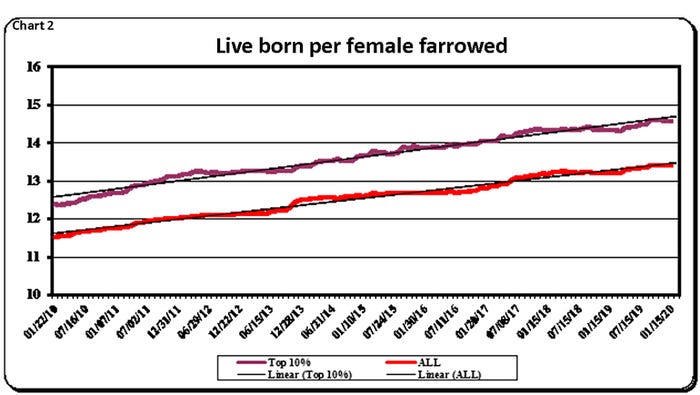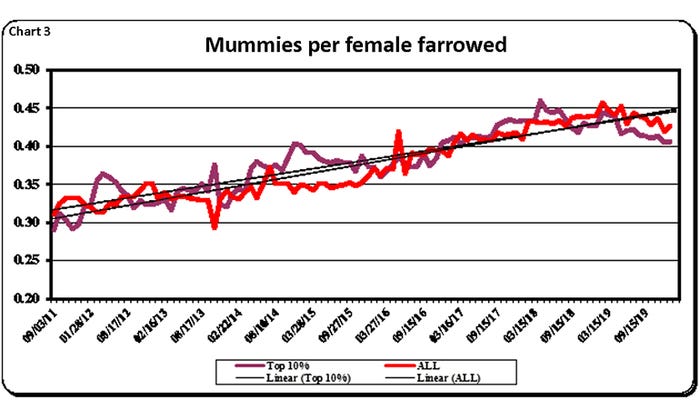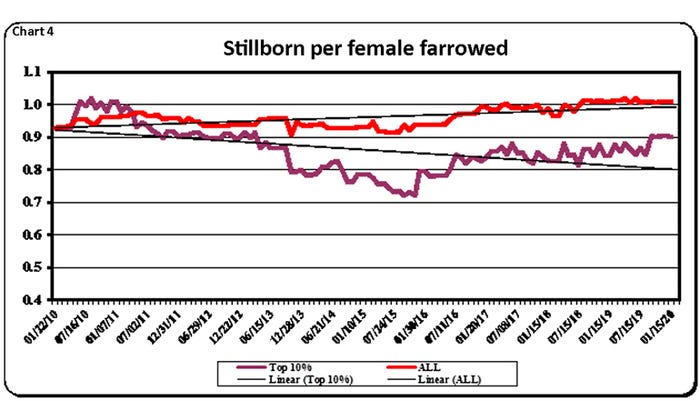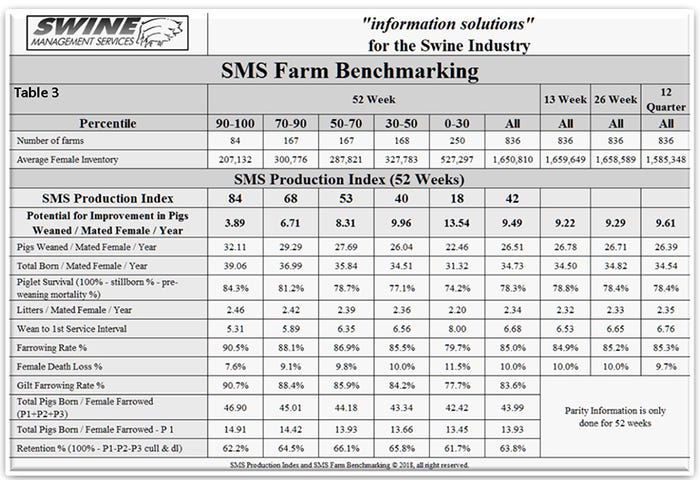What can you change to drive up live born and save more pigs?
What change have you made in farrowing to improve Day 1 pig care?

Last month we looked at total born, now it is time to look at what you need to do increase live born.
The book "The Goal" by Eliyahu M. Goldratt had a very big impact on how I look at what I need to work on today, tomorrow, next week, next month and next year. I have these three questions hanging on the wall right over the top of my computer monitor.
What to change?
What to change to?
How to cause the change?
You should be asking yourself these three questions every day.
When we break down total born per female farrowed there are three components: Live born per female farrowed, mummies per litter and stillborn pigs per litter. In the next four charts you will see that data broke out for the last 10 years.
Chart 1 is the total born per female farrowed from 2010-20. Total born for the all farms has gone from 12.7 pigs in 2010 to 14.9 pigs in 2020, a 16.6% improvement. The Top 10% farms have gone from 13.6 pigs in 2010 to 15.9 pigs in 2020, a 16.5% improvement. This shows us how much genetic improvement that has taken place over 10 years and the potential that genetic companies have to produce more pigs. The question to farms is how do you save more of those extra pigs?

Chart 2 is the Swine Management Services history from 2010 to present for live born per female farrowed. Live born has gone for all farms from 11.5 pigs in 2010 to 13.4 pigs in 2020, a 1.9 pig improvement or a 16.3% improvement. The Top 10% farms started at 12.4 pigs in 2010 and moved up to 14.6 pigs in 2020, a 2.2 pig improvement or a 17.5% improvement. The Top 10% farms improved by 0.3 (1.2%) more pigs than the all farms.

The question to farms is what are you doing to increase live born at your farm? Does that start with increasing total born especially for Parity 1 females or lowering mummies and stillborn pigs?
Chart 3 looks at the change in mummies per female farrowed from 2010-20. Mummies have gone up 0.15 in the all farms, but up only 0.10 in the Top 10% farms. Is the increase in mummies due to larger litters which may have uterine crowding or health challenges at the farms?

Chart 4 is the last 10 years of stillborn pigs per female farrowed. The all farms have increased by 0.1 pigs from 0.9 to 1.00 pigs and the Top 10% have taken a different path starting in 2010 at 1.00 pigs down as low as 0.70 pigs at the end of 2015 and then back up to 0.90 pigs end of 2019, so an overall drop of 0.10 pigs. If you look at stillborn pig distribution across all the 830-plus farms, you will see a range of less than 0.2 to greater than 2.20 pig per litter. In most farms, those extra born live pigs can be improved by making changes to farrowing house management to lower stillborn pig. Most of the time, stillborn pigs are bigger pigs that if saved survive and are weaned. Some suggested management changes to lower stillborn pigs are marking sows with higher number of stillborn pigs or larger litters and spend more time with her during the farrowing period, check sows farrowing every 20-30 minutes and provide assistance if needed, and do more sleeving during the farrowing process especially at the end of farrowing when sows are getting tired.

Table 1 of SMS production numbers breaks the farms out by percentages: 90-100, 70-90, 50-70, 0-30, all, and last 13 weeks, 26 weeks and last 12 quarters based on pig weaned per mated female per year. Along with total pigs born and pigs born live per female the table also has mummies and stillborn pigs. There is no difference in mummies per female farrowed between any of the groups ranging from 0.41 (2.6%) to 0.43 (2.8%) / female.

Stillborn pigs show a different story. The Top 10 % have 0.9 (5.6%) stillborn pigs per female, to 1.07 (7.5%) stillborn pigs per female for the bottom 30 %, and average at 1.01(6.8%) stillborn pigs per female.
Table 2 shows SMS production numbers broke out by parity starting with Parity 0 to Parity 7-plus females. As shown in the table, total pigs born per female starts at 13.95 pigs, peaks at 15.70 pigs for Parity 4 and drops to 14.54 pigs for Parity 7-plus females. Pigs born live per female starts at 12.80 pigs and moves up to 14.13 pigs for Parity 4 and down to 12.61 pigs for Parity 7-plus females. Mummies for Parity 1 were at 0.39 (2.8%) pigs up to 0.48 (3.1%) pigs for Parity 5-6 and down to 0.46 (3.2%) pigs for Parity 7-plus. Stillborn pigs start at 0.76 (5.5%) pigs for Parity 1 at 0.74 (5.1%) pigs up to 1.47 (10.1%) for Parity 7-plus litters with average at 1.01 (6.8%).

Through our SMS Farm Analysis program and consulting we try to answer the first two questions. How to cause the change will be up to the farm management and staff. The Top 10% have adapted and changed to handling the larger total born and keeping stillborn pigs lower so those farms are weaning a higher percent of the pigs in 2020 than they were in 2010.
What is your farm doing to get more of the genetic potential from your genetic choice? What change have you made in farrowing to improve Day 1 pig care, attend more sows farrowing and lower stillborn pigs?
Table 3 provides the 52-week rolling averages for 11 production numbers represented in the SMS Production Index. The numbers are separated by 90-100%, the 70-90%, the 50-70%, the 30-50% and the 0-30% groups. We also included the 13-week, 26-week and 12-quarter averages. These numbers represent what we feel are the key production numbers to look at to evaluate the farm's performance.

At SMS, our mission statement is to provide "Information solutions for the swine industry." We feel with the creation of different SMS Benchmarking databases for all production areas we now have more detailed information to share with the swine industry. If your farm would like to be part of the SMS Benchmarking databases, or if you have suggestions on production areas to write columns about, contact Mark Rix or Ron Ketchem. We enjoy being a part of the NHF Daily team. Previous columns can be found at NationalHogFarmer.com.
Sources: Ron Ketchem and Mark Rix, who are solely responsible for the information provided, and wholly own the information. Informa Business Media and all its subsidiaries are not responsible for any of the content contained in this information asset.
About the Author(s)
You May Also Like



